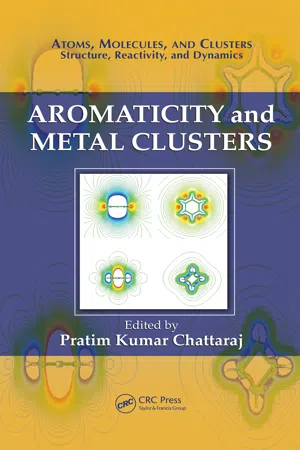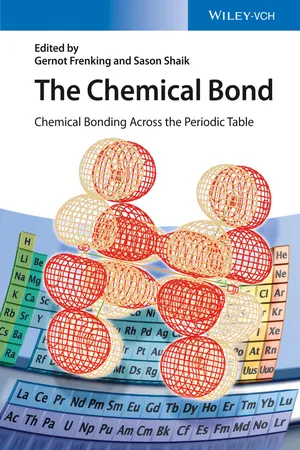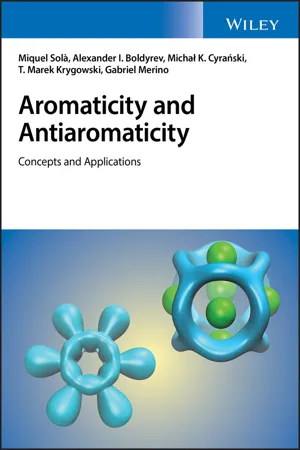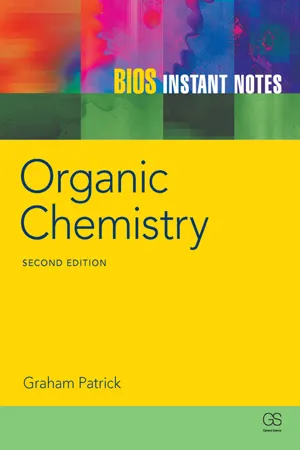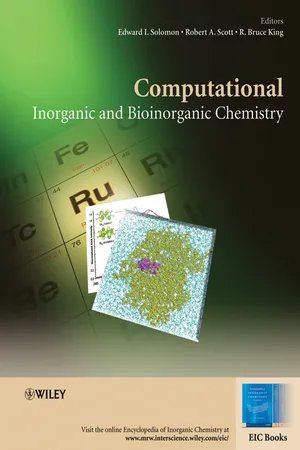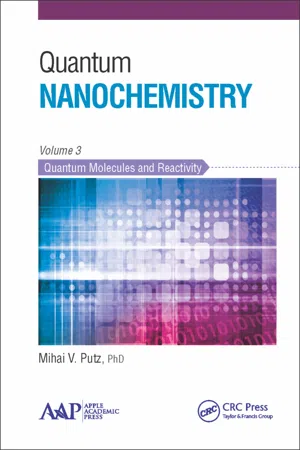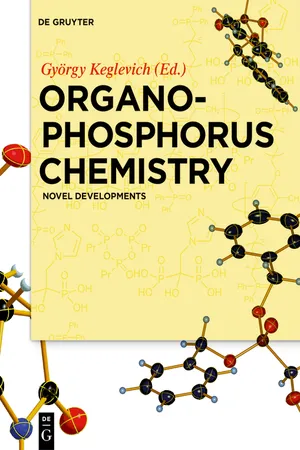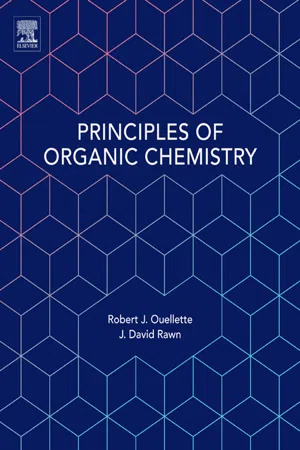Chemistry
Aromaticity
Aromaticity refers to the special stability and unique reactivity of certain cyclic compounds, known as aromatic compounds. These compounds typically contain a ring of alternating single and double bonds, and they often exhibit a characteristic "aromatic" odor. Aromaticity is a key concept in organic chemistry and is associated with the delocalization of electrons within the ring structure.
Written by Perlego with AI-assistance
Related key terms
1 of 5
9 Key excerpts on "Aromaticity"
- eBook - PDF
- Pratim Kumar Chattaraj(Author)
- 2010(Publication Date)
- CRC Press(Publisher)
Although different definitions and indices of Aromaticity have their own flaws, qualitatively there has never been a real disagreement on the fact that aromatic compounds are characterized by special stability and this additional stabi-lization is due to the cyclic electron delocalization [15]. In other words, Aromaticity is essentially an excess property , that is, a deviation from an additive scheme and it is not a directly measurable experimental quantity. 4 Aromaticity and Metal Clusters In 2005, Schleyer and coworkers [16, p. 3844] proposed a qualitative definition of Aromaticity as Aromaticity is a manifestation of electron delocalization in closed circuits, either in two or in three dimensions. This results in energy lowering, often quite substantial, and a variety of unusual chemical and physical properties. These include a tendency toward bond length equalization, unusual reactivity, and characteristic spectroscopic features. Since Aromaticity is related to the induced ring currents, magnetic properties are particularly important for its detection and evaluation. Despite many controversial arguments regarding the definition and physical ori-gin of Aromaticity [1,15–17], the concept of Aromaticity has crossed the boundary of benzenoid hydrocarbons [with (4 n + 2) π -electrons] to include heterosystems [50] like pyridine, thiophine, cations such as tropylium [12] and cyclopropenium [13], anions like cyclopentadienyl [51], organometallic systems, namely ferrocene [52], purely carbon-free systems [53,54], namely P 5 − , [(P 5 ) 2 Ti] 2 − . The three-dimensional Aromaticity of boron-based clusters [55] and of fullerenes [56], the homoAromaticity of cationic systems [57], Aromaticity of triplet state annulenes [58], and pericyclic transition states [59] has enlarged the concept of Aromaticity. - eBook - ePub
The Chemical Bond
Chemical Bonding Across the Periodic Table
- Gernot Frenking, Sason Shaik(Authors)
- 2014(Publication Date)
- Wiley-VCH(Publisher)
14 Chemical Bonding in Inorganic Aromatic CompoundsIvan A. Popov and Alexander I. Boldyrev14.1 Introduction
The concept of Aromaticity was born in chemistry soon after Faraday discovered benzene. Chemists noticed that certain chemicals containing benzene ring are not particularly reactive in spite of having unsaturated carbon atoms. The term Aromaticity was introduced in chemistry by Kekulé [1–3], who associated Aromaticity with the presence of C6 units in aromatic compounds. Kekulé assumed that the similarity to benzene is essential for a compound to be aromatic. This concept undergoes a significant transformation nowadays. According to the IUPAC's definition, Aromaticity is a concept of spatial and electronic structure of cyclic molecular systems displaying the effects of cyclic electron delocalization which provide for their enhanced thermodynamic stability (relative to acyclic structural analogues) and tendency to retain the structural type in the course of chemical transformations. A quantitative assessment of the degree of Aromaticity is given by the value of the resonance energy. It may also be evaluated by the energies of relevant isodesmic and homodesmotic reactions. Along with energetic criteria of Aromaticity, important and complementary are also a structural criterion (the lesser the alternation of bond lengths in the rings, the greater is the Aromaticity of the molecule) and a magnetic criterion (existence of the diamagnetic ring current induced in a conjugated cyclic molecule by an external magnetic field and manifested by an exaltation and anisotropy of magnetic susceptibility). [4] Initially, Aromaticity was associated with planar molecules and with delocalization of π-electrons. On the basis of quantum chemical analysis of molecular orbitals (MOs) the famous 4n + 2 π-electrons Hückel's [5, 6] rule was proposed for aromatic molecules. Breslow [7, 8] introduced in 1970 the concept of antiAromaticity, which can be understood as the destabilization of the cyclic systems possessing 4n - eBook - ePub
Aromaticity and Antiaromaticity
Concepts and Applications
- Miquel Solà, Alexander I. Boldyrev, Michal K. Cyrañski, Tadeusz M. Krygowski, Gabriel Merino(Authors)
- 2022(Publication Date)
- Wiley(Publisher)
3 Aromaticity from Organic to Inorganic Compounds“Human science fragments everything in order to understand it, kills everything in order to examine it.”Leo Tolstoy3.1 Introduction
Initially the concept of Aromaticity was introduced in organic chemistry. Thus, after Michael Faraday reported the isolation of benzene by distillation in 1825 [1] and noted that it was much less reactive than other unsaturated hydrocarbons, Kekulé introduced the term aromatic for a general classification of benzene derivatives [2] . Kekulé also observed a characteristic odor or fragrance of these substances and related them to relatively low chemical reactivity. Subsequent research in the area of Aromaticity revealed that the low reactivity of “aromatic” compounds with unsaturated carbon–carbon bonds is not associated with the aroma. Instead, the exceptional stability and low reactivity was recognized to originate from peculiarities of the chemical bonding and electronic structure. Hückel [3] demonstrated that a closed‐shell monocyclic system should have 4n + 2 valence π‐electrons in order to be aromatic. The concept of antiAromaticity, relating to the corresponding destabilization seen in cyclic systems with 4n π‐electrons, was introduced by Breslow [4 , 5 ]. Dewar introduced σ‐Aromaticity in order to explain the conjugation pattern in cyclopropane [6] . However, Schleyer and coworkers proved that cyclopropene is not a σ‐aromatic molecule [7] . The first doubly aromatic system, the 3,5‐dehydrophenyl cation, was identified by Chandrasekhar, Jemmis, and Schleyer as being doubly (σ‐ and π‐) aromatic [8] . All these are milestone works in advancing Aromaticity, antiAromaticity, and double Aromaticity concepts in organic chemistry. The concept of Aromaticity has been extended into inorganic chemistry. It turns out that Aromaticity in inorganic chemistry is more complex than in organic chemistry. Participation of d‐atomic orbitals (AOs) and f‐AOs in chemical bonding metal systems allows to introduce δ‐Aromaticity/antiAromaticity and φ‐Aromaticity/antiAromaticity [9] (see chapter 12 of Ref. [10] for further details). These new types of Aromaticity lead to complicated combination of aromaticities and antiaromaticities. Finally, a term conflicting Aromaticity introduced by Boldyrev and Wang [8] deals with the simultaneous presence of one of more types of Aromaticity and one or more types of antiAromaticity simultaneously. There are a few reviews [9 –23 - eBook - ePub
- Graham Patrick(Author)
- 2004(Publication Date)
- Taylor & Francis(Publisher)
SECTION I — AROMATIC CHEMISTRY
I1 Aromaticity
Key Notes
Definition Aromatic compounds such as benzene are more stable than suggested from their structure. They undergo reactions which retain the aromatic ring system, and behave differently from alkenes or polyenes. Hückel rule Aromatic compounds are cyclic and planar with sp 2 hybridized atoms. They also obey the Hückel rule and have (4n + 2) π electrons where n = 1, 2, 3, ... Aromatic systems can be monocyclic or polycyclic, neutral, or charged. Related topic (A4) sp 2 Hybridization Definition
The term aromatic was originally applied to benzene-like structures because of the distinctive aroma of these compounds, but the term now means something different in modern chemistry. Aromatic compounds undergo distinctive reactions which set them apart from other functional groups. They are highly unsaturated compounds, but unlike alkenes and alkynes, they are relatively unreactive and will tend to undergo reactions which involve a retention of their unsaturation. We have already discussed the reasons for the stability of benzene in Section A4 . Benzene is a six-membered ring structure with three formal double bonds (Figure 1a ). However, the six π electrons involved are not localized between any two carbon atoms. Instead, they are delocalized around the ring which results in an increased stability. This is why benzene is often written with a circle in the center of the ring to signify the delocalization of the six π electrons (Figure 1b ). Reactions which disrupt this delocalization are not favored since it means a loss of stability, so benzene undergoes reactions where the aromatic ring system is retained. All six carbon atoms in benzene are sp 2 hybridized, and the molecule itself is cyclic and planar — the planarity being necessary if the 2p atomic orbitals on each carbon atom are to overlap and result in delocalization.Figure 1. Representations of benzene. - Edward I. Solomon, Robert A. Scott, R. Bruce King, Edward I. Solomon, Robert A. Scott, R. Bruce King(Authors)
- 2013(Publication Date)
- Wiley(Publisher)
Multiple Aromaticity, Multiple AntiAromaticity, and Conflicting Aromaticity in Inorganic Systems Dmitry Yu. Zubarev and Alexander I. Boldyrev Utah State University, Logan, UT, USA 1 INTRODUCTION Initially, the concept of Aromaticity was introduced in organic chemistry. After Michael Faraday reported the isolation of benzene by distillation in 1825 1 and noted that it was much less reactive than other unsaturated hydrocarbons, Kekulé introduced the term aromatic for a general classification of benzene derivatives. 2 Kekulé also observed a characteristic odor or fragrance of these substances and related them to relatively low chemical reactivity. Since then the concept of Aromaticity has been extended to inorganic chemistry. Subsequent research in the area of Aromaticity revealed that the low reactivity of “aromatic” compounds with unsaturated carbon-carbon bonds is not associated with the aroma. Instead, the exceptional stability and low reactivity were recognized to originate from peculiarities of the chemical bonding and electronic structure. The major breakthrough in this direction was made by Huckel, 3 who demonstrated that a closed-shell monocyclic system should have 4 n + 2 valence π -electrons in order to be aromatic. Today, the concept of Aromaticity is a very diverse one. It includes antiAromaticity, multiple Aromaticity, multiple antiAromaticity, conflicting Aromaticity, island Aromaticity, Möbius Aromaticity, three-dimensional Aromaticity, Aromaticity, and antiAromaticity for open-shell systems (partial Aromaticity and partial antiAromaticity). This diversity is based on specific characteristics of the electronic structure of a particular chemical system. The concept of antiAromaticity, relating to the corresponding destabilization seen in cyclic systems with 4 n π-electrons, was introduced by Breslow 4, 5 and is perhaps best understood in cyclobutadiene- eBook - PDF
Quantum Nanochemistry, Volume Three
Quantum Molecules and Reactivity
- Mihai V. Putz(Author)
- 2016(Publication Date)
- Apple Academic Press(Publisher)
However, the best of them overall seems to remain the consecrated HF scheme, since acquiring the highest number of grades summated throughout Tables 4.8 and 4.9. As such, a new challenge appears since the present results recommend that correlation does not count too much in Aromaticity or reactivity modeling. Nevertheless, fur-ther studies with larger set of molecules and types of aromatics should be address for testing whether or not the advanced Aromaticity (Aroma1-5) rules are preserved or in which degree they may be generalized or modi-fied such that being in accordance with the principles of chemical bond -ing and reactivity (Putz, 2010a). However, since at the end the Aromaticity appears as describing the sta-bility character of molecular sample its connection with a reactivity index seems natural, although systematically ignored so far. In this respect, the present work focuses on how the electronegativity and chemical hardness based- Aromaticity scales are behaving respecting other constructed on a direct observable quantum quantity – the polarizability in this case. This because the polarizability quantity is fundamental in quantum mechanics and usually associated with the second order Stark effect that can be com-puted within the perturbation theory, see the Volume II of the present five-volumes (Putz, 2016); then, the two ways of seeing a molecular structure were employed in introducing the actual absolute Aromaticity definition (Putz, 2010a) (i) the molecule viewed as composed by the constituting atoms ( AIM ); and (ii) the molecule viewed from its spectra of molecular orbitals ( MOL ). The two molecular perspectives may be associated with the pre- and post- bonding stages of chemical bond at equilibrium; therefore, the - eBook - PDF
- Stanley E. Manahan(Author)
- 2009(Publication Date)
- CRC Press(Publisher)
Aromatic compounds have , in Figure 9.7. Aromatic compounds have ring structures and are held together in part by particularly stable bonds that contain ring structures and are held together in part by particularly stable bonds that contain delocalized clouds of so-called delocalized clouds of so-called p (Greek letter pi) electrons. (Greek letter pi) electrons. In an oversimplified sense, the structure of benzene can be visualized as In an oversimplified sense, the structure of benzene can be visualized as resonating between the two equivalent structures shown on the left in Figure 9.7 by resonating between the two equivalent structures shown on the left in Figure 9.7 by the shifting of electrons in chemical bonds to form a hybrid structure. This structure the shifting of electrons in chemical bonds to form a hybrid structure. This structure can be shown more simply and accurately by a hexagon with a circle in it. can be shown more simply and accurately by a hexagon with a circle in it. Aromatic compounds have special characteristics of Aromatic compounds have special characteristics of Aromaticity Aromaticity , which , which include a low hydrogen: carbon atomic ratio; C—C bonds that are quite strong and include a low hydrogen: carbon atomic ratio; C—C bonds that are quite strong and of intermediate length between such bonds in alkanes and those in alkenes; tendency of intermediate length between such bonds in alkanes and those in alkenes; tendency to undergo substitution reactions rather than the addition reactions characteristic to undergo substitution reactions rather than the addition reactions characteristic of alkenes; and delocalization of of alkenes; and delocalization of π electrons over several carbon atoms. - eBook - ePub
- György Keglevich(Author)
- 2018(Publication Date)
- De Gruyter(Publisher)
17 ] was also introduced with the discovery of the fullerene family.Aromatic stabilizing or antiaromatic destabilizing effects determine, whether a particular molecule is isolable or not. According to the well-known 4n+2 and 4n rules, it may seem trivial to distinguish between Aromaticity and antiAromaticity. However, sophisticated and accurate theoretical and experimental investigations have often led to opposite conclusions. The precise quantification of aromatic characteristics of ring structures is not trivial. Quantitative methods are required to replace the initial, inexact descriptions. In most cases, these theoretical methods may be classified into four categories based on fundamentally different concepts:(1)On energetic grounds, several methods are favoured. First of all, Aromaticity (AM%) may be a useful parameter for classifying these methods [18 ]. Aromatic Stabilization Enthalpy (H ASE ) or Energy (E ASE ) values are also indicative [19 – 24 ], and homodesmic [20 , 23 , 25 ] hydrogenation [18 ] or isomerization (H ISE ) reactions [26 ] may also be suitable for the definition of antiaromatic destabilization.(2)On geometrical grounds: The indices HOMA [27 , 28 ], Bird [29 ]; and BDSHRT [30 ] are based on the analysis of geometrical data obtained experimentally or theoretically; however, this method is not suitable for the determination of the antiaromatic character.(3)On NMR characteristics: Magnetic shielding properties [31 ], such as nucleus independent chemical shift (NICS) [21 , 32 ], may also be good indicators of Aromaticity/antiAromaticity.(4)Using reactivity criteria [23 ] to study the transition states (TS) of various reactions of aromatic and antiaromatic compounds may also provide useful information.Previously, only aromatic phosphorus compounds (phosphinines and phospholes) appeared in the literature, which exhibited aromatic rings [13 , 33 – 41 ]. Here we focus on the degree of Aromaticity and antiAromaticity (Figure 14.1 ) of single P-heterocyclic structures with or without an additional (N or O) heteroatom, and we also discuss their synthetic consequences. Surprisingly, detailed investigations have shown many four-membered phosphorus compounds to be non-aromatic rather than antiaromatic. The three- [38 , 39 , 42 , 43 - eBook - ePub
- Robert J. Ouellette, J. David Rawn(Authors)
- 2015(Publication Date)
- Elsevier(Publisher)
5Aromatic Compounds
5.1 Aromatic Compounds
The term aromatic means “fragrant” (Ancient Greek, aroma). For this reason many fragrant substances were called “aromatic compounds.” Many of these compounds contain a benzene ring (Section 1.6 ) that is bonded to one or more substituents. Oil of sassafras, oil of wintergreen, and vanillin are well-known examples of fragrant, aromatic compounds.Today, the classification of aromatic compounds is no longer based on odor because many compounds containing a benzene ring are not fragrant. Many aromatic compounds are solids that have little or no odor. Solid aromatic compounds include the pain relievers, or analgesics, aspirin, ibuprofen, and acetaminophen, and the antibiotic chloramphenicol.The common feature of aromatic compounds is not their odor, but the benzene ring. This six-carbon unit is usually not affected by reactants that alter the rest of the structure. The distinguishing characteristic of aromatic compounds is the very low reactivity of the benzene ring.5.2 Aromaticity
Benzene, C6 H6 , is highly unsaturated—it has six fewer hydrogen atoms than cyclohexane, C6 H12 – its cyclic saturated counterpart. Although benzene is represented by a hexagon that contains three double bonds, unlike alkenes it does not undergo addition reactions with reagents such as bromine, HBr, or water. The lack of reactivity of benzene contradicts what we know about unsaturated compounds. That is, benzene does not behave like the “triene” depicted by its Lewis structure. Benzene typically undergoes substitution reactions, a reaction not typical of alkenes. Benzene reacts with bromine, in the presence of iron(III) bromide as a catalyst, to give a single monosubstituted product, C6 H5 Br.This result indicates that all six hydrogen atoms of benzene are chemically equivalent. There are three possible isomeric dibromobenzenes, C6 H4 Br2
Index pages curate the most relevant extracts from our library of academic textbooks. They’ve been created using an in-house natural language model (NLM), each adding context and meaning to key research topics.
